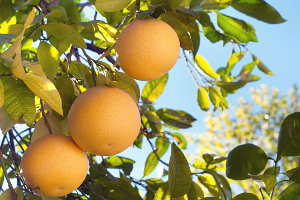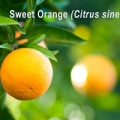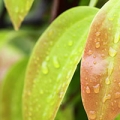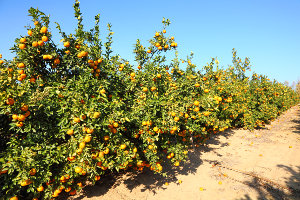The Best Grapefruit Pure Essential Oil from Quinessence
 Grapefruit essential oil is one of the most popular citrus oils in aromatherapy, with a fresh and tangy fragrance that never fails to bring a welcome boost to the senses.
Grapefruit essential oil is one of the most popular citrus oils in aromatherapy, with a fresh and tangy fragrance that never fails to bring a welcome boost to the senses.
Like all citrus fruits, the grapefruit belongs to the Rutaceae family, which are a large family of shrubs, trees and occasionally herbs.
This botanical family is of great economic importance and provides a wide range of citrus crops to the world of commerce; grapefruit, lemons, limes, oranges and tangerines, as well as some ornamental species. After the orange, the grapefruit is the second most important citrus fruit worldwide.
Physical description
Citrus paradisi reaches a height of 4 to 6 metres (13-20 ft) and sometimes 13 metres (42 ft) with great age. It has a rounded top of spreading branches, and twigs that normally bear short, supple thorns. The ovate evergreen leaves are dark green above, and paler below with white, 4-petalled flowers in clusters at the axils (leaf stems).
The fruit is almost round or oblate and grows in clusters of up to 6, although this figure varies greatly. Citrus paradisi thrives in a warm sub-tropical climate, and the humidity affects the thickness of the peel; in arid conditions the peel is thicker and subsequently the juice content is lower. A large tree can produce as much as 500 to 700 fruit per annum.
Historical Background
The grapefruit was first described in 1750 by the reverend Griffith Hughes who called it the ‘forbidden fruit’ of Barbados. Later in 1789, Patrick Browne reported it as growing in most parts of Jamaica and he referred to it as ‘forbidden fruit’ or ‘smaller shaddock’. Shaddock was a popluar name for the pummelo at that time, and is a giant citrus fruit that can reach 10-11 inches in diameter, with a firm flesh and less juice than a grapefruit. It is thought to have been named after Captain Shaddock of the East India Company who introduced the tree to the West Indies.
Tangy grapefruit is now believed by botanists to be an accidental hybrid of the pummelo (Citrus grandis) and sweet orange (Citrus sinensis), and it was James MacFayden, in his publication ‘Flora of Jamaica’ in 1837 who gave it the botanical name of Citrus paradisi which literally means the ‘fruit of paradise’.
This relatively new fruit tree was introduced to the United States in the mid 1800’s and at first it was grown only as a novelty in Florida. Over the next 100 years it was cultivated throughout many different states, and by 1910 the grapefruit had become an important crop in the Rio Grande Valley, Arizona and California.
Harvesting and extraction
At one time grapefruits were harvested by using picking hooks which often caused damage to the fruit. The modern method is to pick them by hand, using ladders to access the higher branches. Some mechanised methods which shake the tree are sometimes employed, and although this can be 3 times faster than hand-picking it can cause damage to the tree.
Grapefruit essential oil is extracted by cold expression of the peel, yielding a pale yellow or golden yellow coloured oil with an odour characteristic of the fruit and very similar to orange, but with a bitter aspect. The oil glands in grapefruit are located deeper in the peel than with other citrus fruits, which makes it more difficult to extract the oil. Compared to orange or lemon, grapefruit produces far less essential oil and this is why it is more expensive.
Benefits of grapefruit essential oil
Grapefruit essential oil is classed as a top note and has a very wide range of uses due to its uplifting, stimulating and cleansing properties. It is highly effective when used in massage blends to treat cellulite and the elimination of toxins because it helps to stimulate the lymphatic system. In skincare it can be used to help relieve oily and congested skin and has an all-round toning effect on dull skin.
In common with most citrus oils, grapefruit has an antiseptic and antiviral action that can be used to protect against chills and colds. Vaporise it to help kill airborne bacteria and prevent germs from spreading throughout the family or at work. Grapefruit is a useful essential oil to help maintain concentration whilst driving.
On the emotional system it excels with a cleansing and balancing effect that really lifts the spirits when feeling down, or heading for nervous exhaustion and depressive states. It is also effective at the first signs of stress, especially when blended with other emotionally stimulating oils such as sweet basil.
Like all citrus essential oils grapefruit blends easily with many other oils, making a pleasing accord with basil, black pepper, cardamon (and other spice oils), coriander, cypress, geranium, juniper berry, lavender, neroli, palmarosa, petitgrain, pine and rosemary. Grapefruit is also useful in blends to take the sweet or heady edge off oils such as ylang ylang, jasmine, geranium, tuberose etc. It not only smells good when blended with jasmine, but it also helps when used to improve resolve and boost confidence.
Browse Quinessence Grapefruit Essential Oil
Copyright © Quinessence Aromatherapy Ltd 2022.















